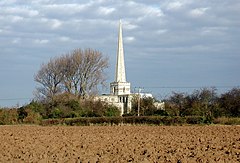Hemingbrough
| Hemingbrough | |
|---|---|
 The spire of Saint Mary's, Hemingbrough, is 191 feet (58 m) tall and was probably added in the early 15th century |
|
| Hemingbrough shown within North Yorkshire | |
| Population | 2,020 (Census 2011) |
| District | |
| Shire county | |
| Region | |
| Country | England |
| Sovereign state | United Kingdom |
| Post town | SELBY |
| Postcode district | YO8 |
| Police | North Yorkshire |
| Fire | North Yorkshire |
| Ambulance | Yorkshire |
| EU Parliament | Yorkshire and the Humber |
Hemingbrough is a small village and civil parish in the Selby district of North Yorkshire, England that is located approximately 5 miles (8 km) from Selby and 4 miles (6.4 km) from Howden on the A63. The village has a 12th-century former collegiate church (Hemingbrough Minster), a Methodist chapel and shops. The village also has a primary school and nursery as well as a playing field for the local children. The surrounding area makes up part of the Humberhead Levels and is flat land mainly used for mixed agriculture. It is thought that from this village came Walter of Hemingbrough, one of Britain's early chroniclers. Writing in the 14th century, he gave us a history beginning with the Norman conquest, now in the British Museum.
Robert de Hemmingburgh, a royal clerk who became Master of the Rolls in Ireland, was born here in the late thirteenth century. Nicholas Bubbewyth, a chancery clerk who became successively, Master of the Rolls, Keeper of the Privy Seal, Lord High Treasurer of England, and Bishop of London, Bishop of Salisbury and Bishop of Bath and Wells, was born in Menthorpe.
In 1989 Caron Keating and Blue Peter visited the village to replace the cockerel on the top of the church spire which had been damaged for several years.
In February 2014, Hemingbrough Parish Council were awarded funds from the Heritage Lottery Fund to help raise awareness of the historical heritage within Hemingbrough Parish to benefit the local community.
The toponym is of uncertain origin. The place is mentioned in the Knýtlinga saga, and the name may be the burh of a Viking named Hemingr. Alternative explanations are that it was the burh of the followers of a man called Hema, or the burh by the fish-weir (Old English hemming).
...
Wikipedia

